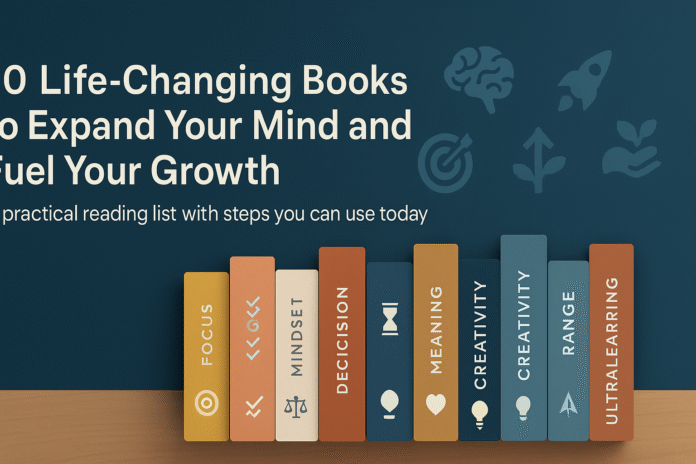If you’ve been feeling stuck or simply hungry for a bigger, braver life, this reading list is your springboard. Below you’ll find ten carefully chosen books that expand how you think, sharpen how you learn, and translate reflection into real-world momentum. You’ll learn how to build better habits, focus deeply, stretch outside your comfort zone, and make meaning in ways that carry you through tough seasons. This guide is for curious professionals, ambitious students, and anyone who senses there’s more potential on the table—and wants a practical way to reach for it. Expect clear summaries, step-by-step ways to apply each book, smart caveats, and a simple plan to turn pages into progress.
Key takeaways
- Read for action, not just inspiration. Every book below includes concrete ways to apply big ideas the same day you learn them.
- Small, consistent moves beat heroic bursts. Track pages, sessions, and tiny experiments to compound gains.
- Mix depth with breadth. Pair “deep work” chapters with “range” experiments to grow both expertise and adaptability.
- Protect your attention. Many gains come from eliminating interruptions and building focus like a skill.
- Measure what matters. Use simple metrics—deep-work hours, habit streaks, shipped outputs—to see progress fast.
1) Thinking, Fast and Slow — Daniel Kahneman
What it is and why it matters
A tour of the two modes of thought you use every day: a rapid, intuitive system and a slower, more deliberate system. Understanding when each helps—or trips you—improves decisions at work, money, relationships, and learning.
Core benefits: Better judgments under uncertainty, fewer costly snap decisions, clearer risk assessment, and a playbook for checking your own biases.
Requirements and low-cost alternatives
- Requirements: The book (print, ebook, or audio).
- Low-cost options: Borrow from a library; search for publisher excerpts and summaries to preview concepts before buying.
- Helpful extras: A notebook or note app for bias “spotting logs.”
Step-by-step to put it into practice
- Spot the trigger. When stakes are high or data is messy, flag “System 1 likely to mislead me.”
- Insert a speed bump. Ask three quick questions: What’s the base rate? What evidence would change my mind? What would I advise a friend?
- Run a premortem. Imagine your decision failed. List three likely reasons and counter them now.
Beginner modifications and progressions
- Beginner: Apply the checklist to one decision per week.
- Progression: Use it daily for hiring, prioritization, investing, or design choices. Teach the framework to a colleague to strengthen your own understanding.
Recommended frequency and metrics
- Frequency: 2–3 focused reading sessions per week; use the checklist on any medium- or high-stakes choice.
- Metrics: Count “decisions with checklist,” number of identified biases, and “reversals avoided.”
Safety, caveats, and common mistakes
- Don’t swing to cynicism—intuition is still valuable in familiar domains.
- Beware “bias hunting” in others while ignoring your own. Start with self-audits.
Mini-plan (example)
- Step 1: Before a big purchase, write the base rate (typical outcome) and three alternative explanations for your enthusiasm.
- Step 2: Delay 24 hours, then decide with fresh eyes.
2) Atomic Habits — James Clear
What it is and why it matters
A practical system for building better habits and breaking unhelpful ones by tweaking cues, environment, and identity. Small, repeatable improvements compound into meaningful change.
Core benefits: Reliable habit formation, fewer false starts, and tools to bounce back quickly after lapses.
Requirements and low-cost alternatives
- Requirements: The book and a simple habit tracker (paper or app).
- Low-cost options: Library copy; index cards as trackers; repurpose a calendar for streaks.
Step-by-step to put it into practice
- Choose one keystone habit. Make it obvious (clear cue), attractive (stack with a reward), easy (two-minute version), and satisfying (visible streak).
- Design your environment. Place cues in your path; remove friction for good behaviors and add friction to temptations.
- Track identity. Write “I am the type of person who ____” and log daily votes for that identity.
Beginner modifications and progressions
- Beginner: Start with a two-minute version (e.g., read one page; do one push-up).
- Progression: Increase by 10–15% per week only after the action is automatic.
Recommended frequency and metrics
- Frequency: Daily repetition is ideal.
- Metrics: Streak length, number of “identity votes,” and completion rate of your two-minute version. Research on habit formation suggests consistency over weeks to months is normal; treat early months as setup, not finish line.
Safety, caveats, and common mistakes
- Don’t chase perfect streaks; focus on “never miss twice.”
- Avoid adding five habits at once—bandwidth is limited.
Mini-plan (example)
- Step 1: After boiling water for tea (cue), read one page (behavior), then check off the calendar (reward).
- Step 2: After two weeks, extend to five pages.
3) Mindset — Carol S. Dweck
What it is and why it matters
A framework for viewing ability as developable rather than fixed. This shift increases resilience, embraces effort as a path to mastery, and reframes failure as feedback.
Core benefits: Greater persistence, more effective feedback loops, and healthier responses to setbacks.
Requirements and low-cost alternatives
- Requirements: The book and a journal.
- Low-cost options: Library copy; use any note app; index cards for “reframe” prompts.
Step-by-step to put it into practice
- Name the voice. When you hear “I’m just not good at this,” label it “fixed voice.”
- Add “yet.” Reframe with “I can’t do this yet—what’s the next skill?”
- Switch to learning goals. Replace outcome goals (“get an A”) with process goals (“study with spaced review 30 minutes, four times/week”).
Beginner modifications and progressions
- Beginner: Write one “yet” reframe per day.
- Progression: Ask for targeted, task-level feedback weekly and track specific skills improved.
Recommended frequency and metrics
- Frequency: Daily micro-reframes; weekly feedback loops.
- Metrics: Count reframes, feedback requests made, and skills broken down into sub-skills.
Safety, caveats, and common mistakes
- A growth lens isn’t magic—skills still require good strategy and practice.
- Don’t weaponize “just work harder.” Keep goals realistic and humane.
Mini-plan (example)
- Step 1: After any mistake, write a “what I learned” sentence.
- Step 2: Book a 10-minute feedback chat focused on one sub-skill.
4) Deep Work — Cal Newport
What it is and why it matters
A method for producing high-quality output by training intense, distraction-free focus. In an interruption-heavy world, this is a rare and decisive advantage.
Core benefits: Faster mastery, better creativity, and higher-value results in fewer hours.
Requirements and low-cost alternatives
- Requirements: The book; a calendar; a quiet space or noise-blocking setup.
- Low-cost options: Library copy; free website blockers; paper “do not disturb” sign.
Step-by-step to put it into practice
- Time-block one session. Start with 30–45 minutes. Turn devices to airplane mode; close the door; set a single, specific objective.
- Scoreboard. Track “deep hours” daily and weekly; aim for consistency, not heroics.
- Rituals and cues. Same place, same drink, same soundtrack—make deep work automatic.
Beginner modifications and progressions
- Beginner: Two sessions/week at 30 minutes.
- Progression: Four to six sessions/week at 60–90 minutes, then string together 2–3 blocks with short breaks.
Recommended frequency and metrics
- Frequency: 3–5 sessions per week.
- Metrics: Deep-work hours, tasks completed in deep mode, and interruptions prevented.
Safety, caveats, and common mistakes
- Don’t stack deep work back-to-back for hours initially; cognitive fatigue is real.
- Multitasking ruins depth—batch shallow work separately.
Mini-plan (example)
- Step 1: Block Tuesday/Thursday 8:00–8:45 a.m. for a single task.
- Step 2: Log your deep hours and summarize what you shipped by Friday.
5) Man’s Search for Meaning — Viktor E. Frankl
What it is and why it matters
A concise memoir and psychological framework showing that purpose—found in work, love, and the stance we take toward suffering—can sustain us through hardship and guide everyday choices.
Core benefits: Stronger resilience under stress, clearer values, and a durable compass for goals.
Requirements and low-cost alternatives
- Requirements: The book; a page for a “values list.”
- Low-cost options: Library copy; free value-clarifying prompts you can jot down anywhere.
Step-by-step to put it into practice
- Clarify your “why.” List top five values and one behavior for each you can do this week.
- Choose your stance. When facing a difficulty, ask: What attitude would honor my values right now?
- Serve beyond self. Identify one person or cause you can meaningfully help this week.
Beginner modifications and progressions
- Beginner: One small “value-aligned” action per day.
- Progression: Build a weekly ritual to review choices against values and adjust plans.
Recommended frequency and metrics
- Frequency: Revisit values weekly; daily micro-actions.
- Metrics: Count value-aligned actions, difficult moments reframed, and “service moments” per week.
Safety, caveats, and common mistakes
- This book is powerful but not a substitute for professional help; if you’re struggling with mental health or trauma, seek qualified care.
- Avoid turning values into perfectionism—aim for direction, not flawlessness.
Mini-plan (example)
- Step 1: Write five values; schedule one 10-minute action for each.
- Step 2: Reflect Friday: Which action felt most meaningful? Do more of that.
6) Range — David Epstein
What it is and why it matters
An argument for breadth: in complex, fast-changing environments, sampling widely and connecting ideas across fields helps you solve novel problems and adapt faster.
Core benefits: Creative problem-solving, better career experiments, and a more resilient skill portfolio.
Requirements and low-cost alternatives
- Requirements: The book; a simple “skill map.”
- Low-cost options: Library copy; free online course previews; podcasts to explore domains before you commit.
Step-by-step to put it into practice
- Run a sampling season. Pick three small projects in different domains (e.g., data viz, storytelling, negotiation).
- Build T-shape skills. Keep one “stem” of depth while adding horizontal breadth.
- Connect dots. For each project, ask, “What method from field A can I apply to field B?”
Beginner modifications and progressions
- Beginner: One small project per month.
- Progression: Two projects running in parallel with clear exit criteria.
Recommended frequency and metrics
- Frequency: Quarterly sampling cycles.
- Metrics: Number of domains sampled, cross-domain ideas applied, and which projects you double down on.
Safety, caveats, and common mistakes
- Don’t confuse dabbling with aimlessness—set learning goals and deliverables for each sample.
- Avoid spreading yourself so thin you never finish a project.
Mini-plan (example)
- Step 1: Month 1 = learn basic storytelling; deliver a 5-minute talk.
- Step 2: Month 2 = basic spreadsheet automation; build a personal dashboard.
7) Grit — Angela Duckworth
What it is and why it matters
A case for sustained passion and perseverance toward long-term, meaningful goals, and how to cultivate both.
Core benefits: More staying power on hard goals, better alignment between interests and effort, and routines that make persistence easier.
Requirements and low-cost alternatives
- Requirements: The book; a “hard-thing” plan; a weekly review.
- Low-cost options: Library copy; journal templates; accountability with a friend.
Step-by-step to put it into practice
- Pick your “hard thing.” Choose one specific, challenging skill you’ll practice consistently.
- Deliberate practice. Break the skill into sub-skills; practice at your edge with feedback; log reps.
- Consistency contract. Commit to a minimum cadence (e.g., 20 focused minutes, four days a week) for 8–12 weeks.
Beginner modifications and progressions
- Beginner: Choose a small scope (one song on guitar; one data function).
- Progression: Increase difficulty only after you meet consistency targets.
Recommended frequency and metrics
- Frequency: 4+ sessions per week of focused, feedback-rich practice.
- Metrics: Sessions completed, deliberate-practice minutes, and milestones shipped.
Safety, caveats, and common mistakes
- Persistence is powerful but not the only success driver; revisit goals periodically so you don’t persist at the wrong thing.
- Don’t equate grit with burnout—schedule rest and stop dates.
Mini-plan (example)
- Step 1: Define your hard thing (e.g., 5-minute conference talk with slides in 8 weeks).
- Step 2: Practice four days a week, get feedback weekly, and ship draft slides by week 4.
8) The War of Art — Steven Pressfield
What it is and why it matters
A short, punchy manifesto about creative resistance—the inner force that keeps you from doing the work that matters—and how to move through it.
Core benefits: Lower friction to start, more consistent creative output, and a healthier relationship with fear and procrastination.
Requirements and low-cost alternatives
- Requirements: The book; a simple “ship list” of outputs.
- Low-cost options: Library copy; free text editor; a timer.
Step-by-step to put it into practice
- Set a daily appointment. Same time, same place, independent of mood.
- Define “done.” Decide what “shipping” means (e.g., 300 words, one sketch, one pitch).
- Protect the streak. Even a tiny win counts—just don’t miss the date.
Beginner modifications and progressions
- Beginner: 15–20 minutes per day, five days a week.
- Progression: Increase duration or complexity; add public deadlines.
Recommended frequency and metrics
- Frequency: Daily is best; five days per week works.
- Metrics: Days you shipped, pieces completed, and time to “first draft.”
Safety, caveats, and common mistakes
- Don’t measure only by outcomes; honor the process.
- Beware perfectionism pretending to be “high standards.”
Mini-plan (example)
- Step 1: 7:30–7:50 a.m., write 200 words, Monday–Friday.
- Step 2: Post a weekly progress note every Friday.
9) Sapiens — Yuval Noah Harari
What it is and why it matters
A sweeping narrative of human history that shows how shared beliefs and stories shape culture, economics, and institutions. The big-picture perspective helps you understand today’s systems—and your place within them.
Core benefits: Systems thinking, context for modern life, and a stronger grasp of how narratives influence behavior.
Requirements and low-cost alternatives
- Requirements: The book.
- Low-cost options: Library copy; illustrated and audio editions if you prefer visuals or listening.
Step-by-step to put it into practice
- Track big themes. As you read, list three recurring patterns (e.g., cooperation through shared myths, unintended consequences of tech).
- Apply locally. Pick a work or community issue and map the stories, incentives, and norms that maintain it.
- Test a new narrative. Propose one small change to the “story” and measure its effect (e.g., reframing a team goal).
Beginner modifications and progressions
- Beginner: Summarize each part in five bullet points.
- Progression: Share a 5-minute “big idea” talk with your team or friends.
Recommended frequency and metrics
- Frequency: 2–3 sessions a week.
- Metrics: Patterns identified, reframes attempted, and outcomes from small narrative shifts.
Safety, caveats, and common mistakes
- Treat broad historical claims as starting points for inquiry, not dogma.
- Balance synthesis with humility—human history is messy.
Mini-plan (example)
- Step 1: Identify one workplace “myth” (e.g., “only urgent tasks matter”).
- Step 2: Pilot a weekly “important-not-urgent” block and share results.
10) Ultralearning — Scott Young
What it is and why it matters
A strategy for self-directed, aggressive learning projects that compress time to skill. You’ll scope projects, learn directly by doing, and build the meta-skills to teach yourself almost anything.
Core benefits: Faster upskilling, stronger autonomy as a learner, and a portfolio that proves competence.
Requirements and low-cost alternatives
- Requirements: The book; a defined project; a feedback source (mentor, community, tests).
- Low-cost options: Free syllabi; open-course materials; public forums for feedback.
Step-by-step to put it into practice
- Scope your project. Define a concrete outcome (“Build and launch a one-page website portfolio in 30 days”).
- Build a curriculum. Collect 3–5 top resources; set milestones; schedule daily blocks.
- Bias to directness. Spend most time doing the thing (build, present, converse), with spaced review to retain knowledge.
Beginner modifications and progressions
- Beginner: 30-day project at 30–45 minutes per day.
- Progression: 60–90 minutes per day; add public accountability and formal assessments.
Recommended frequency and metrics
- Frequency: 5–6 days per week.
- Metrics: Milestones hit, outputs shipped, and retention checks from spaced quizzes.
Safety, caveats, and common mistakes
- Don’t over-research—fight “syllabus hoarding.”
- Validate outcomes with real users, not just your own impressions.
Mini-plan (example)
- Step 1: Write a one-page project charter: outcome, deadline, daily schedule, feedback source.
- Step 2: Ship version 1 by day 10; gather feedback; iterate weekly.
Quick-start checklist
- Choose one book to start.
- Block two 45-minute reading sessions this week (calendar them).
- Create a Capture-Decide-Do note page: capture ideas, decide the one behavior to test, do it within 48 hours.
- Pick one metric to track (e.g., pages read, deep-work hours, or shipped outputs).
- Schedule a 10-minute Friday review to log wins and tweak next week’s plan.
Troubleshooting & common pitfalls
- “I keep forgetting to read.” Tie reading to a stable cue (after lunch; before bed) and prepare your environment (book on the pillow, app pinned to your home screen).
- “I read but don’t remember.” Add spaced reviews. After each session, write three bullets, then review them two days later and again a week later.
- “I understand the ideas but don’t act.” Commit to tiny experiments within 48 hours: one habit tweak, one 30-minute deep-work block, one shipped micro-output.
- “I’m overwhelmed by ten books.” Work in seasons: pick one “depth” book and one “breadth” book per month.
- “Interruptions wreck my focus.” Use airplane mode, door closed, and a visible “focus block until HH:MM” sign. Batch messages afterward.
- “I’m burning out.” Cap sessions at 90 minutes with real breaks. Sleep, nutrition, and movement support cognition.
- “I’m not sure it’s working.” Track leading indicators (sessions, pages, hours, shipped outputs) and a single lagging result (e.g., finished a talk, built a prototype). Momentum shows up first in the leading indicators.
How to measure progress
- Inputs: Reading sessions per week, pages read, deep-work hours, deliberate-practice minutes, habit streaks.
- Outputs: Shipped drafts, talks given, prototypes built, problems solved, decisions improved by checklists.
- Learning durability: Spaced-review scores (can you recall the three key ideas of each book one week later?).
- Behavior change: Count “identity votes” (days you acted like the person you aim to become).
- Reflection quality: Weekly review notes and decisions changed because of them.
A simple 4-week starter plan
Week 1 — Focus & Habits
- Read: Atomic Habits (first half), Deep Work (first two chapters).
- Actions: Start one two-minute keystone habit; schedule two 45-minute deep-work blocks.
- Metrics: Habit streak; deep-work hours.
Week 2 — Decisions & Mindset
- Read: Thinking, Fast and Slow (core chapters on biases), Mindset (first half).
- Actions: Use the decision checklist on one work or life choice; write five “yet” reframes.
- Metrics: Checklists used; reframes logged.
Week 3 — Meaning & Breadth
- Read: Man’s Search for Meaning, Range (first half).
- Actions: List five values and one action for each; pick one small “sampling project.”
- Metrics: Value-aligned actions; project milestone.
Week 4 — Build & Ship
- Read: Ultralearning (first half), The War of Art.
- Actions: Draft a 30-day ultralearning charter and ship a first micro-output (a 300-word blog, a 60-second demo, or a 3-slide explainer).
- Metrics: Charter completed; output shipped; feedback gathered.
Repeat the cycle with the remaining halves/chapters in month two, or rotate in Sapiens as your weekend “big picture” read.
FAQs
1) What order should I read these in?
Start with a “behavioral engine” pair: Atomic Habits for small daily wins and Deep Work to protect attention. Layer Mindset and Thinking, Fast and Slow next for better learning and decisions. Then choose meaning (Man’s Search for Meaning), breadth (Range), or shipping (The War of Art), and finish with Ultralearning. Keep Sapiens as a weekend or travel read.
2) Can I listen to audiobooks instead of reading?
Yes. For concept-heavy books, pause to take brief notes or set chapter markers. For application, pair listening with a tiny same-day experiment so ideas don’t evaporate.
3) How much should I read per day?
Two focused 30–45 minute sessions per week beat sporadic marathons. If you can, add a 10-minute nightly “wind-down” read for momentum.
4) How do I remember more of what I read?
Use three bullets per session, then schedule a two-day and seven-day review. Brief self-quizzes (“what were the three ideas?”) help cement memory.
5) I’m busy—what’s the minimum effective dose?
One micro-habit, one 30-minute deep-work block, and one shipped micro-output per week. Progress compounds from there.
6) Do I need to buy all the books?
No. Libraries, used copies, ebooks, and audiobooks are all great. Start with one or two titles; borrow before buying if unsure.
7) How do I apply these books to a team?
Run a monthly “book to behavior” meeting: choose one idea, define a one-week experiment, run it, and share results at the next stand-up.
8) What if a book doesn’t click?
Quit fast and guilt-free. Swap it for another on the list. The point is growth, not completionism.
9) How do I balance breadth and depth?
Adopt “T-shape” reading: one deep title you actively practice from, plus one breadth title for context. Review monthly which served you most.
10) Is it okay to annotate books?
Absolutely. Write in the margins, use sticky flags, or keep a digital note with page numbers. Capture one behavior to try per chapter.
11) How fast will I see results?
Inputs move first. You’ll notice better focus and small wins within weeks; bigger results show up after consistent application and iteration.
12) What if reading about meaning or mindset stirs up tough emotions?
Pause and take care. These books can be powerful prompts; they’re not therapy. Consider talking to a trusted person or a qualified professional if needed.
Conclusion
Books can change how you think—and how you live—when you treat them as toolkits, not trophies. Pick one title, schedule two sessions, run one experiment, and track one metric. Do that for four weeks and you’ll feel your attention sharpen, your habits stick, and your confidence rise.
CTA: Pick your first book from this list, schedule two reading sessions this week, and commit to one tiny experiment within 48 hours.
References
- Thinking, Fast and Slow — Book page, Farrar, Straus and Giroux/Macmillan (publisher page overview), 2011/2013. https://us.macmillan.com/books/9780374533557/thinkingfastandslow/
- Atomic Habits — Book page, Penguin Random House (publisher page), 2018. https://www.penguinrandomhouse.com/books/543993/atomic-habits-by-james-clear/
- Atomic Habits — Author’s overview page, JamesClear.com, n.d. https://jamesclear.com/atomic-habits
- Mindset: The New Psychology of Success — Book page, Penguin Random House (publisher page), 2006/2007. https://www.penguinrandomhouse.com/books/44330/mindset-by-carol-s-dweck-phd/
- Deep Work: Rules for Focused Success in a Distracted World — Book page, Hachette/Grand Central Publishing (publisher page), Jan 5, 2016. https://www.hachettebookgroup.com/titles/cal-newport/deep-work/9781455586691/
- Man’s Search for Meaning — Book page, Beacon Press (publisher page), various editions. https://www.beacon.org/Mans-Search-for-Meaning-P2247.aspx
- Range: Why Generalists Triumph in a Specialized World — Book page, Penguin Random House (publisher page), 2019. https://www.penguinrandomhouse.com/books/550188/range-by-david-epstein/
- Grit: The Power of Passion and Perseverance — Book page, Simon & Schuster (publisher page), 2016. https://www.simonandschuster.com/books/Grit/Angela-Duckworth/9781501111112/
- The War of Art — Book page, Black Irish Books (publisher page), 2002. https://blackirishbooks.com/product/the-war-of-art/





































Our main priority is to provide comfort, and elegance in our luxury cars and limousines. Our goal is to offer seamless airport transfers in Dubai for both personal and professional trips.